
|
|

December 23 & 30, 2005
Mount Wilson, Revisited and Annotated (part II)
By SCOTT FYBUSH
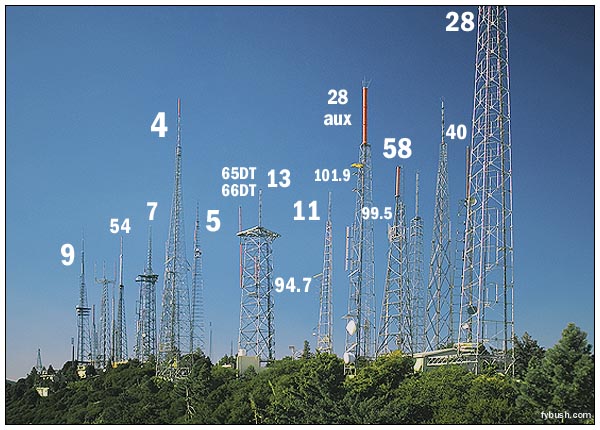
For the next few weeks, we're featuring some of the images you'll find in our new Tower Site Calendar 2006, along with some stories and extra pictures from each visit. This week, we continue with pictures from our April 2005 return to one of our very favorite sites anywhere in the country - Mount Wilson, more than a mile in the air above Los Angeles.

|
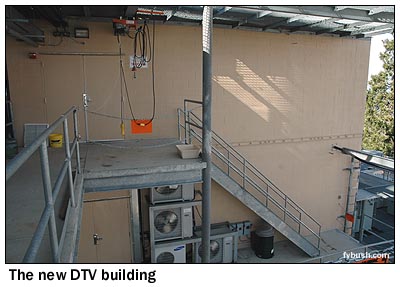
|
In this week's installment, we're still on "Mount Alta," the central core (and highest point) of Mount Wilson, and one of five significant clusters of towers on the mountain.
(Previous installments, linked from last week's installment, visited the others - the KCBS-TV facility, the KPFK/KMZT/KLVE towers just west of Alta, the Fox compound east of Alta and the Mount Harvard site just to the south and below Mount Wilson proper.)
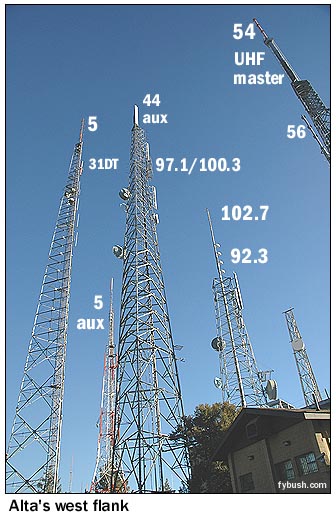 This
central core of Mount Alta has become a crowded place in recent
years, as a number of stations that started out elsewhere have
migrated to Mount Wilson.
This
central core of Mount Alta has become a crowded place in recent
years, as a number of stations that started out elsewhere have
migrated to Mount Wilson.
That list includes several UHF stations, such as Orange County's commercial KDOC (Channel 56) and noncommercial KOCE (Channel 50). KDOC moved its analog service up here in May, 2001, and signed on its DTV from here a few years later. Its DTV shares a room in the new building next to the Post Office (Allcom) building with KOCE's analog and digital transmitters, and its DTV shares the new master antenna with both KOCE signals.
(The master antenna is actually two antennas, since it carries a number of stations on adjacent channels, which are hard to combine into a single antenna. In addition to KDOC-DT and KOCE-TV/DT, it carries newcomer KXLA-TV/DT, licensed to Rancho Palos Verdes, and the DTV signal of KJLA Ventura, whose analog channel 57 transmitter is many miles up the coast in Ventura County.)
In the picture at left, we're standing on the northern flank of Alta, next to the ABC building, and looking east. That's the old Channel 46 building in the foreground, though I think channel 46 has moved to the Univision/Channel 34 building that's off to the right of this frame, behind ABC. The tower at the center of the frame holds an aux antenna for KXLA's analog signal, as well as a pair of ERI cogwheel antennas for two of the more recent FMs to move up to Mount Wilson. KLSX (97.1) and KKBT (100.3) both have their transmitters in the Allcom building, behind the Channel 46 building. Also in that building are KIIS (102.7) and KHHT (92.3), on that shorter tower to the right.
How can you tell that KIIS and KHHT are veterans on the mountain, while KLSX and KKBT came along later? It's all about the grandfathering. With nearly identical heights above average terrain, KHHT (which has been here since its KFAC-FM days in the fifties) runs 42 kW ERP. KIIS runs 8 kW, which is still far above the maximum a standard class B station can run at 2,960 feet above average terrain. KLSX, though a relative newcomer to the mountain (it spent most of its life at Flint Peak in Glendale), gets 21 kW, maintaining the grandfathering it enjoyed from its long-ago days as KGBS-FM. And KKBT chugs along with 5.3 kW, which is still substantially more than a by-the-books class B signal would enjoy up here. (Doug Smith's excellent W9WI.com site contains a helpful list of grandfathered FMs, including pretty much everything on Wilson, in which he calculates that a textbook derated class B up here would run about 1.5 kW ERP.)
It's pretty safe to say, in fact, that there's no site anywhere else in the country with as wide a range of "class B" power levels as Mount Wilson offers. There's everything from the 110,000 watts of KPFK on 90.7 to the 84,000 watts of KBIG on 104.3 all the way down to the 4,800 watts of KSCA on 101.9, about which we'll hear more in a moment. The neat thing is, the sheer height of Mount Wilson, coupled with its line of sight to pretty much the entire market, means that even the least of the signals up here enjoys terrific coverage of the market. And the terrain that surrounds the Los Angeles market, coupled with the lack of protection for any signal beyond a standard class B contour, means that even with all that huge power, the largest of the signals up here don't get out that much better than the smallest. Even the very smallest signal here, public radio KPCC (89.3), does remarkably well with its 600-watt signal. (It comes from a two-bay antenna on the monopole that's topped by the KDOC-TV antenna.)
 |

|
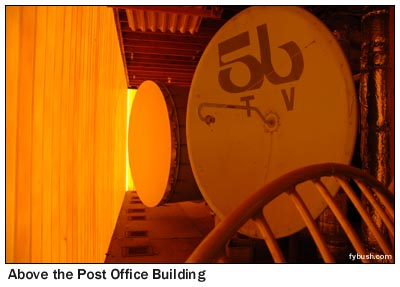 What
we see above are a few of the newer TV installations on the mountain.
The KOCE/KDOC-DT room is in the new three-story building, shown
above, that was built just a few years ago by American Tower.
KXLA is in this building as well, and I think KJLA-DT is here,
too.
What
we see above are a few of the newer TV installations on the mountain.
The KOCE/KDOC-DT room is in the new three-story building, shown
above, that was built just a few years ago by American Tower.
KXLA is in this building as well, and I think KJLA-DT is here,
too.
In the view above, we're standing on the top of the stairway, next to the Allcom/Post Office building. To our left, a door leads into the top floor of the Allcom building, where a forest of STL dishes sits behind the plastic sheeting that protects it from the weather. At 5,700 feet above sea level, they do indeed have winter up here, so keeping those dishes enclosed is a good thing indeed.
The new DTV combiner is behind the STLs, braced above the Allcom building and reached through the stairway that leads to the roof of that building.
We showed you that last week. This week, we offer a couple of images from inside the second floor of the Allcom building, where a locked door at one end of the corridor goes into the KAZA (Channel 54) transmitter room. Along the hallway are small enclosures for a variety of LPTV and FM stations, including KKBT (100.3), where a backup transmitter still features a "WTFM" nameplate (this would go back to the days when LA's 100.3 and New York's 103.5 were both under Evergreen - or was it Chancellor? - ownership) and KIIS-FM (102.7), with its pair of Nautels pumping top-40 tunes out to the Southland.
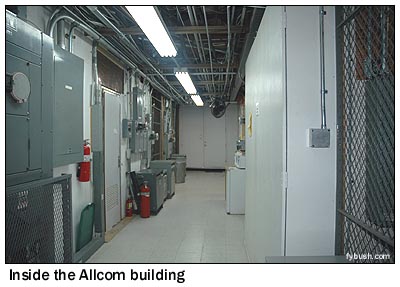 |
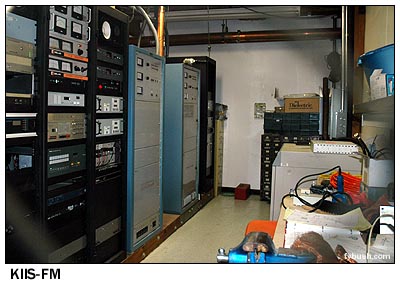
|
One more visit awaits us on this Mount Wilson trip, and that's the very oldest transmitter site on Mount Alta. KTLA (Channel 5) has been here since 1947, and the photo below (a picture of a picture that sits on the wall inside the building) shows a much earlier version of the facility here. The unpainted tower in the "then" picture is the painted tower at the right of the "now" picture - the original tower, still in use as channel 5's auxiliary tower. That water tower is long gone, and the microwave dishes moved inside, behind that plastic sheeting, when the wooden building gave way to today's concrete-block transmitter building.
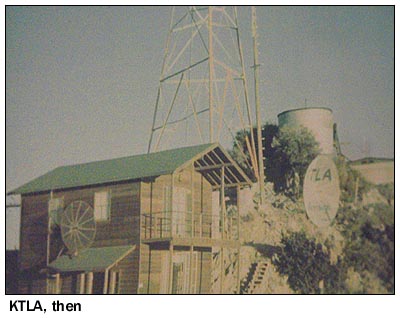 |
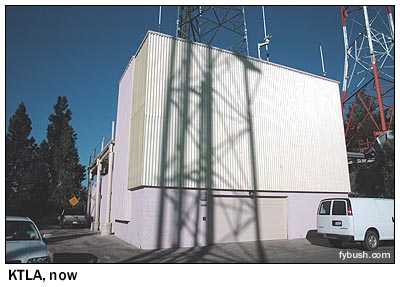
|
And what's inside the transmitter building? A nice big transmitter room, with the DTV transmitter (channel 31) over to the left and the analog transmitter (a solid-state Harris) on the right, as well as a small kitchen, an office and a tidy little bedroom for the unlucky engineer who gets stuck up here when the weather turns bad. (Yes, this site is staffed for one shift a day, and you'd probably staff your transmitter site, too, if you were a major TV station in the number-two market and the drive from the studio to the site could easily take well over an hour, in good weather!)
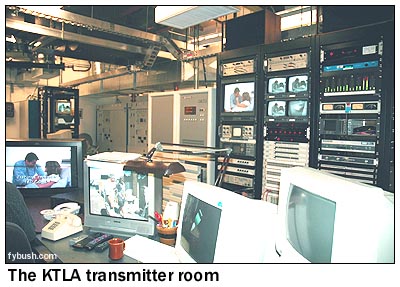 |
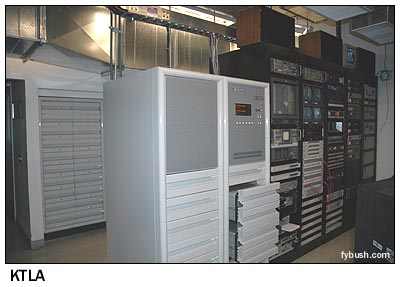
|
There's a generator out back, and microwave dishes galore upstairs. A small room off the main transmitter room houses STL gear and a backup transmitter for KSCA (101.9 Glendale), which once used the KTLA tower as its primary site but has since relocated to the Fox compound at the eastern edge of the mountain, along the road that leads to the Mount Wilson Observatory.
Which brings us back to the picture above - yes, the same one you'll find in your 2006 Tower Site Calendar. With Larry Lopez' help, we're finally able to identify the cluster of UHF and FM facilities at the east end of the Fox compound: that's KSCA on the KCET (Channel 28) backup tower, and Salem's KKLA (99.5) on a very low-profile Shively panel antenna attached to the KLCS (Channel 58) tower next to it. KCET's main tower rises out of the frame on the right, and behind them is TBN's KTBN (Channel 40).
And that, for now, is all we have to show you of Mount Wilson, not to mention all we have to offer you for Tower Site of the Week for 2005. We'll take a week off for the holidays, and then we'll be back on January 6, 2006 with a look at the KFI tower site, after the tower collapse a year ago. See you then!
LIKE THAT MOUNT WILSON PICTURE? You should see it in printed form, sans annotation, in the 2006 Tower Site Calendar! Click here for ordering information!
- Previous Site of the Week: Mount Wilson, re-re-revisited, part I
- Next Week: KFI, Los Angeles
- Site of the Week INDEX!
- How can you help support Site of the Week? Click here!
- Submit your suggestions for a future Site of the Week!
